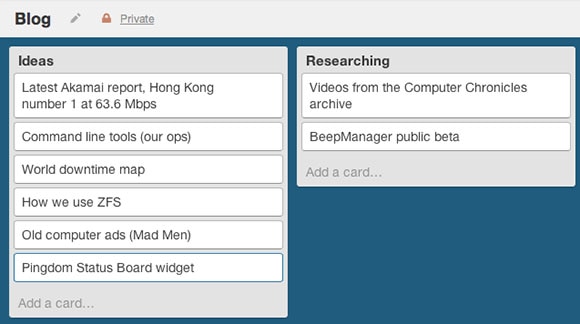At any given time, we have several people within Pingdom working on blog posts for the Royal Pingdom blog. Add to the mix that everyone has busy schedules with other tasks, the work on the blog is a melting pot made for scheduling problems and conflicts.
What keeps us sane and on track is a clever online project management service you may have heard of called Trello. Here is a description of how we use it, perhaps it can help you out as well.
A project for the blog

Since there are already great resources, which can help you get going with Trello, we’re not covering the basics here. Instead, we focus on how we use Trello, in the hope that it may inspire you.
First of all we have a project called simply “Blog,” where we keep everything that is going on with the Royal blog. We have many other projects too, of course, but we try to keep what’s blog-related in this particular project.
Workflow – lists

Then we’ve devised a sort of workflow for the blog, meaning each article goes through a number of stages throughout its lifetime.
The start of that worlkflow is that everyone in the company contributes with ideas for possible blog posts. These ideas are then put into a list called simply “Ideas.”
For each idea (a card in Trello), a possible title is entered, a brief description of what the article would be about, links to external pages and resources, whose idea it is, and anything else worth noting.
Triage

At a weekly meeting with representatives from all corners of the company, this list of ideas is gone through. Each idea is discussed briefly and we move each idea to another list (more on that later), based on if we believe in it, if we put it off until later, or if we decide it’s not worth pursuing.
The goal is to empty the list of ideas each week so we can start filling it with new ideas. For us, this is a critical stage because we’ve found that if we don’t empty this list every week it just keeps on growing and will eventually be a huge burden to deal with.
Writing process
If an article has passed the initial triage, it gets moved into another list before any actual work goes into writing it.
The other lists we have are:
- Researching
- To be published
- Finish and publish
- Maybe later
Researching
Most ideas that make it through triage goes to the “Researching” list. That basically means we believe in the idea and are excited about its possibilities, but we have to look into it more. This could be we need some more data, some references, or some other resources.
Whatever resources that are gathered are attached to the card, as much as possible. The people in Pingdom working on the article are added as members, and we use Labels to show what type of article it is (such as news, tutorial, interview, etc.)
We use Google Docs for writing the text most of the time, and shared folders in DropBox for pictures, PDFs, etc.

To be published
If an idea is still viable after this research, it moves to the “To be published” list. Some ideas go straight from triage to here although that is rare.
Here an article is in a sort of holding pattern, like airplanes coming in for landing at an airport. They wait for a writer to be free so that they can take the piece and finish it.
Finish and publish
Finally, in the “Finish and publish” list are the articles we’re actively working on finishing. This is the last stop before they get put into WordPress and published for the world to see.
Once an article has been published it is archived in Trello.

Maybe later
Some cards from “Ideas” end up in “Maybe later.” These are ideas that we don’t even know at the time if we should go ahead to the research phase. Yet we’re not ready to throw them away completely.
The maybe list we look through once in awhile, perhaps every couple of months or so. We have no set schedule for it, but when we do look at it we have to empty it out. By far most ideas that end up here are later archived without any other action taken. In other words, they are discarded. A few ideas are, however, brought back to life.
Would this work for you?
Every company is of course different so what works for us may not work for you. We have found Trello to be very suitable for how we want to work with our blogging and communications, much more so than anything else we’ve tried. But that doesn’t mean that we’ve perfected our use of Trello, nor that it’s without things that could be improved. There’s always something that can be changed or tuned just a little bit.
If you write for a company blog, what do you use for planning and managing the blog? Let us know in the comments below.
























